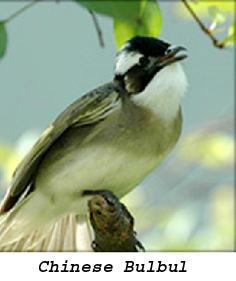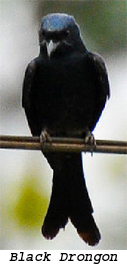Birds in Wah Yan (Kowloon) John C. Coghlan, S.J.
Most visitors to Hong Kong would probably agree that Nathan Road must be one of the busiest streets in the world. Yet, within five minutes of Nathan Road, is a haven of peace and beauty. I refer of course, to the grounds of our school. Fr. Naylor tells me that some years ago a survey showed that there were seventy five different trees and bushes in our grounds. For this our thanks are due in large part to Fr. Foley. Without his work Wah Yan would not be what it is. Equally remarkable is the fact that, in the middle of this huge modern city, twenty or more different kinds of birds can be seen with the minimum expense of energy. In fact, I have identified thirty seven different kinds of birds in Wah Yan and I am convinced that our bird population is growing in number and variety. Why is this happening? Firstly, due to development in Kowloon and the New Territories there is increasing pressure on suitable habitats for birds. Secondly, as Mr. Chiu pointed out to me, our trees are maturing and are thus more attractive to birds. Thirdly, it should be remembered that Wah Yan is a significant section of an “informal” green belt which runs from Kowloon Tong, through D.B.S., Kowloon Hospital, Homantin Hill, Wah Yan, King’s Park, Queen Elizabeth Hospital and Kowloon Cricket Club to Gun Club Hill Barracks.
I would like to share with my readers some of the joy and pleasure I experience from seeing and hearing so many birds all through the year.
I guarantee that except for high summer, if you look out the classroom windows you will regularly see five or six different kind of birds at any one time. Everywhere there are Sparrows 麻雀, Mynahs 八哥 flying around in abundance. They are black, but snow white flashes show on their wings when they are flying. At the moment, in early May, they are nesting high up under the over-hanging roof above 4B2 classroom. On the football field will be Magpies 喜鵲, handsome black and white birds. Two kinds of Bulbul, the Chinese Bulbul 白頭翁 and the Crested Bulbul 高雞冠 are common in Wah Yan. The Chinese Bulbul is a particularly attractive bird. Some years ago, a pair of Chinese Bulbuls nested in the creeper on the last flight of stairs up to the Students’ Library. Hundreds of students passed within feet of the nest every day. What a joy that four lovely young Bulbuls safely left the nest to join their friends in the freedom of Wah Yan.
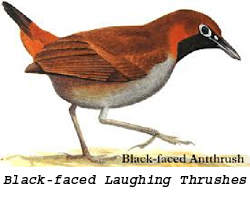
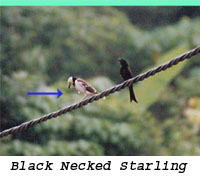 On the lawn in front of the school office you will regularly see a party of Blacked-Faced Laughing Thrushes 七姊妹. They chatter and scold one another without a break. Is the Chinese name for them appropriate? A recent success story is the spread of the Black-Necked Starling 黑領椋鳥 from the New Territories to urban Kowloon. You can see them daily and hear their cheerful, chortling song on any Wah Yan grassy patch of the same size. A pair is nesting in one of the big trees near the corner of Wylie Road and Waterloo Road.
On the lawn in front of the school office you will regularly see a party of Blacked-Faced Laughing Thrushes 七姊妹. They chatter and scold one another without a break. Is the Chinese name for them appropriate? A recent success story is the spread of the Black-Necked Starling 黑領椋鳥 from the New Territories to urban Kowloon. You can see them daily and hear their cheerful, chortling song on any Wah Yan grassy patch of the same size. A pair is nesting in one of the big trees near the corner of Wylie Road and Waterloo Road.

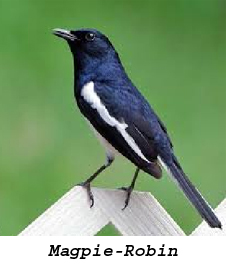 Behind the School Hall and on the hill behind the Canteen you can see and hear, flying free or in cages, Hwa-meis 畫眉. They are among our best singers. All around Wah Yan you can’t help noticing the cheeky, aggressive Magpie-Robin 豬屎渣. It sings well. It is very like a miniature Magpie but is in no way related to it.
Behind the School Hall and on the hill behind the Canteen you can see and hear, flying free or in cages, Hwa-meis 畫眉. They are among our best singers. All around Wah Yan you can’t help noticing the cheeky, aggressive Magpie-Robin 豬屎渣. It sings well. It is very like a miniature Magpie but is in no way related to it.

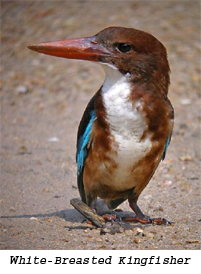 One of the glories of Wah Yan is a White-Breasted Kingfisher 白胸魚郎. It regularly squats on the goalposts or streaks over to the bushes along Wylie Road, flashing a glorious turquoise in the sun. Its call is a long sad, trilling laugh. Perhaps it’s lonely. Here I must share with you what Charles Ryder said in Brideshead Revisited about his lover, Julia. “That night and the night after and the night after, wherever she went, always in her own little circle of intimates, she brought a moment of joy, such as strikes deep to the heart on the river’s bank when the kingfisher suddenly flares across the water.” That’s how I feel, too, when I see our kingfisher or the even more beautiful Common Kingfisher 釣魚郎 in the stream above Tai Lam Chung or in Ho Chung valley.
One of the glories of Wah Yan is a White-Breasted Kingfisher 白胸魚郎. It regularly squats on the goalposts or streaks over to the bushes along Wylie Road, flashing a glorious turquoise in the sun. Its call is a long sad, trilling laugh. Perhaps it’s lonely. Here I must share with you what Charles Ryder said in Brideshead Revisited about his lover, Julia. “That night and the night after and the night after, wherever she went, always in her own little circle of intimates, she brought a moment of joy, such as strikes deep to the heart on the river’s bank when the kingfisher suddenly flares across the water.” That’s how I feel, too, when I see our kingfisher or the even more beautiful Common Kingfisher 釣魚郎 in the stream above Tai Lam Chung or in Ho Chung valley.
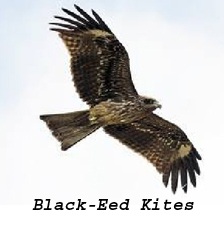 Look up to the blue sky and you will see one or two Black-Eared Kites 麻鷹circling lazily or suddenly spiralling up almost out of vision. On a quiet day you may hear a weak mewing sound like a small kitten calling. Believe it or not it’s the Kite.
Look up to the blue sky and you will see one or two Black-Eared Kites 麻鷹circling lazily or suddenly spiralling up almost out of vision. On a quiet day you may hear a weak mewing sound like a small kitten calling. Believe it or not it’s the Kite.

 From the aerials on the flats in King’s Park you can often hear the cawing of Jungle Crows 大咀烏鴉. Sometimes they fly right over Wah Yan on their way to a change of scenery. The Jungle Crow’s spread to urban Kowloon is almost as remarkable as that of the Black-Necked Starling. Come back to school in the dusk or at night and you will hear bands of House Swifts 小白腰雨燕 screaming as they scythe at top speed through the air. Some of them nest way up near the top of the Y.M.C.A. If your eyes are good you can see their nests adhering firmly to a ledge just under the roof.
From the aerials on the flats in King’s Park you can often hear the cawing of Jungle Crows 大咀烏鴉. Sometimes they fly right over Wah Yan on their way to a change of scenery. The Jungle Crow’s spread to urban Kowloon is almost as remarkable as that of the Black-Necked Starling. Come back to school in the dusk or at night and you will hear bands of House Swifts 小白腰雨燕 screaming as they scythe at top speed through the air. Some of them nest way up near the top of the Y.M.C.A. If your eyes are good you can see their nests adhering firmly to a ledge just under the roof.
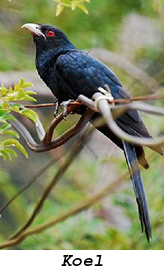
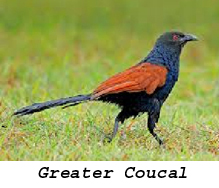
 In late spring you have surely heard the frequent and rather frantic calls of the Koel 噪鵲. It’s a very shy bird. The other birds don’t like it as it is a parasite. It lays its eggs in other birds’ nests. Two cousins of the Koel, the Greater Coucal 毛雞and the Indian Cuckoo 四聲杜鵑 also enjoy the spring/summer hospitality of Wah Yan. The Coucal is a glorious bird. You have to be lucky to see him. He, too, is very shy, even though he has magnificent black and orange plumage to show off. The Indian Cuckoo keeps on asking for “One more bottle”. Listen to him. I wish someone would give his a bottle when he calls at 4:15 a.m.
In late spring you have surely heard the frequent and rather frantic calls of the Koel 噪鵲. It’s a very shy bird. The other birds don’t like it as it is a parasite. It lays its eggs in other birds’ nests. Two cousins of the Koel, the Greater Coucal 毛雞and the Indian Cuckoo 四聲杜鵑 also enjoy the spring/summer hospitality of Wah Yan. The Coucal is a glorious bird. You have to be lucky to see him. He, too, is very shy, even though he has magnificent black and orange plumage to show off. The Indian Cuckoo keeps on asking for “One more bottle”. Listen to him. I wish someone would give his a bottle when he calls at 4:15 a.m.
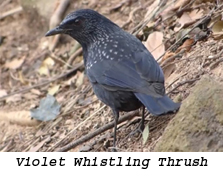
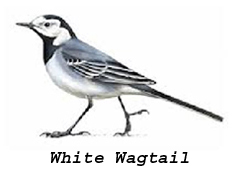 In the winter a White Wagtail 白鹡鸰 makes itself at home on the lawns, especially the one in front of the School Office. It’s a visitor from North China. Occasionally a Violet Whistling Thrush 紫嘯鶇 visits the hill just behind the canteen. Seen in the sun, it really is violet with silvery spangles. It has a low persistent, whistling call.
In the winter a White Wagtail 白鹡鸰 makes itself at home on the lawns, especially the one in front of the School Office. It’s a visitor from North China. Occasionally a Violet Whistling Thrush 紫嘯鶇 visits the hill just behind the canteen. Seen in the sun, it really is violet with silvery spangles. It has a low persistent, whistling call.
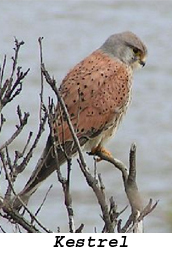 From the birds’ point of view it is fortunate that a Kestrel 紅隼 only rarely turns his attention to Wah Yan. Kestrels are birds of prey. This particular Kestrel often perches on the roof of Y.M.C.A. I have never worked out what it lives on.
From the birds’ point of view it is fortunate that a Kestrel 紅隼 only rarely turns his attention to Wah Yan. Kestrels are birds of prey. This particular Kestrel often perches on the roof of Y.M.C.A. I have never worked out what it lives on.
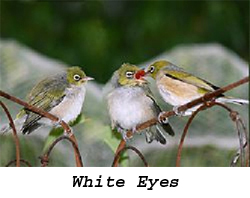
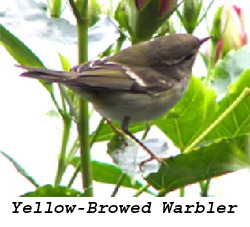
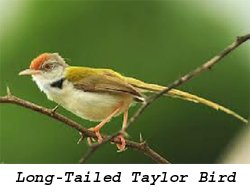 At certain times of the year flocks of White Eyes 相思 and Yellow-Browed Warblers 黃眉柳鶯 comb the trees and bushes for the tiny insects which are their food. The Long-Tailed Taylor Bird 裁縫鳥 with its chip, chip, chipping song is a relative of theirs and also enjoys the pickings in Wah Yan.
At certain times of the year flocks of White Eyes 相思 and Yellow-Browed Warblers 黃眉柳鶯 comb the trees and bushes for the tiny insects which are their food. The Long-Tailed Taylor Bird 裁縫鳥 with its chip, chip, chipping song is a relative of theirs and also enjoys the pickings in Wah Yan.
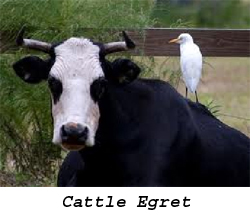 Very, very occasionally a Cattle Egret 牛背鴛 stands forlorn and bewildered in the middle of the football field. Perhaps he is dazed by the traffic, far from his Shataukok home.
Very, very occasionally a Cattle Egret 牛背鴛 stands forlorn and bewildered in the middle of the football field. Perhaps he is dazed by the traffic, far from his Shataukok home.

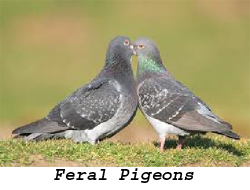 Spotted Doves 珠頸斑鳩 and their close relatives Feral Pigeons 原鴿 abound in Wah Yan. You can hear the clap, clap, clap of their wings when they are startled into flight.
Spotted Doves 珠頸斑鳩 and their close relatives Feral Pigeons 原鴿 abound in Wah Yan. You can hear the clap, clap, clap of their wings when they are startled into flight.
Spring, too, sees the arrival of some Black Drongoes 黑捲尾. They are jet black birds. They have a strange, fluttering flight and seem about to lose their long tail feathers at any moment.
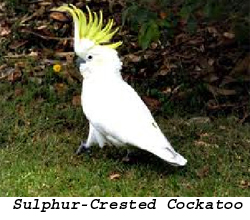 Two species which were once cage birds but which now seem to be established as breeding in Hong Kong are to me, at least, rather
Two species which were once cage birds but which now seem to be established as breeding in Hong Kong are to me, at least, rather 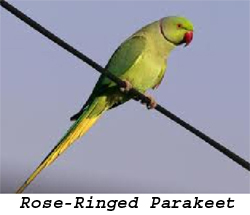 unwelcome visitors. They are raucous birds and one of them the Sulphur-Crested Cockatoo 琉璜冠大鸚鹉 is suspected of damaging trees by stripping their bark. The other bird is the Rose-ringed Parakeet 红領缘鸚鹉.
unwelcome visitors. They are raucous birds and one of them the Sulphur-Crested Cockatoo 琉璜冠大鸚鹉 is suspected of damaging trees by stripping their bark. The other bird is the Rose-ringed Parakeet 红領缘鸚鹉.
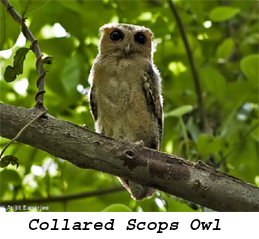 A few weeks ago, late at night, I was thrilled to sense rather than see, the ghostly presence of a Collared Scops Owl 領角貓頭鷹 whooshing along the line of trees beside the Chapel. Mr. Chiu confirmed to me that some years ago, some Form 6 students found a young Owl near the Common Room. I hope that it didn’t end up on the dissecting-table!
A few weeks ago, late at night, I was thrilled to sense rather than see, the ghostly presence of a Collared Scops Owl 領角貓頭鷹 whooshing along the line of trees beside the Chapel. Mr. Chiu confirmed to me that some years ago, some Form 6 students found a young Owl near the Common Room. I hope that it didn’t end up on the dissecting-table!
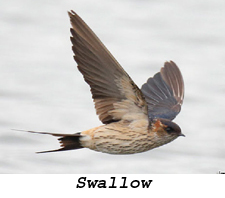 Swallows 燕子nest every year under the arcades of some of the shops on Sai Yee Street. Perhaps like their human counterparts, some of them take a break from daily duties by coming over to Wah Yan. Certainly some swallows are to be seen here regularly
Swallows 燕子nest every year under the arcades of some of the shops on Sai Yee Street. Perhaps like their human counterparts, some of them take a break from daily duties by coming over to Wah Yan. Certainly some swallows are to be seen here regularly
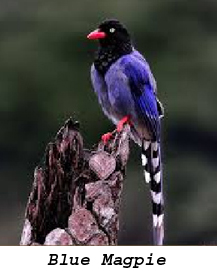 The magnificent Blue Magpie 藍喜鵲 often swoops across the concrete football field from Homantin Hill to scramble and screech through the trees on King’s Park Hill. Blue Magpies are nest robbers like their black and white cousins mentioned earlier.
The magnificent Blue Magpie 藍喜鵲 often swoops across the concrete football field from Homantin Hill to scramble and screech through the trees on King’s Park Hill. Blue Magpies are nest robbers like their black and white cousins mentioned earlier.
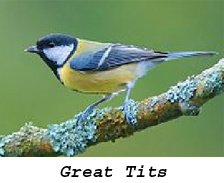
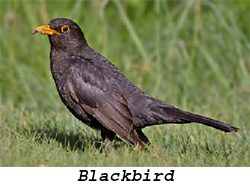 Great Tits 白臉山雀 are regular visitors. They particularly like pine trees. Early this winter I saw a Blackbird 鳥鵣 near the Common Room. Blackbirds only visit Hong Kong rarely. It is usually regarded as the sign of a cold winter coming. Perhaps this Blackbird panicked at an early cold spell in his native North China.
Great Tits 白臉山雀 are regular visitors. They particularly like pine trees. Early this winter I saw a Blackbird 鳥鵣 near the Common Room. Blackbirds only visit Hong Kong rarely. It is usually regarded as the sign of a cold winter coming. Perhaps this Blackbird panicked at an early cold spell in his native North China.
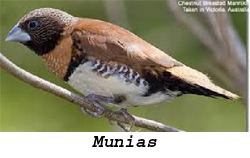 A slightly sad story is that some holy old ladies go to pet shops and buy little Munias 斑文雀. Wishing to do a pious deed, they come up to Wah Yan to release them. Unfortunately, they cannot exist in the wild and so you may sometimes find a dead Munia on the lawns. Munias live in the wild in the New Territories.
A slightly sad story is that some holy old ladies go to pet shops and buy little Munias 斑文雀. Wishing to do a pious deed, they come up to Wah Yan to release them. Unfortunately, they cannot exist in the wild and so you may sometimes find a dead Munia on the lawns. Munias live in the wild in the New Territories.

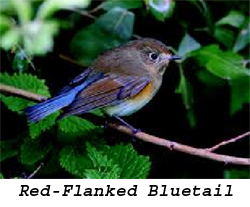 Finally, I have seen a Chinese Greenfinch 金翅雀 in the trees behind the Canteen and a Red-Flanked Bluetail 红脇藍尾鴝 in King’s Park Garden about 55 yards from Wah Yan. Does the Bluetail count as a Wah Yan bird?
Finally, I have seen a Chinese Greenfinch 金翅雀 in the trees behind the Canteen and a Red-Flanked Bluetail 红脇藍尾鴝 in King’s Park Garden about 55 yards from Wah Yan. Does the Bluetail count as a Wah Yan bird?
I have seen several other birds which I couldn’t identify,
I went to Crescent College, Limerick, a Jesuit school, in 1942. In the Jesuit tradition we were, among other things, gently led to an appreciation of the beauty of the world around us. From my very first days in the Crescent I was enthralled by a set of glass-cases full of birds in their “natural” habitats. The students’ Library had some very good books on birds. Since those early days of delight I have been deeply interested in birds. They have given me countless hours of joy and consolation.
Here in Wah Yan students are even luckier than I was in the Crescent. We have a living exhibition of birds all around us. My fond hope is that some of my readers will begin to explore the beauty of the bird life of Wah Yan. All you need is a sense of wonder and curiosity, a little persistence and a simple book on the birds of Hong Kong. Binoculars, check lists and a visit to Antarctica or the Amazon can come later. I promise you loveliness all the days of your life.
[Please click the Thumbnails for larger pictures located in the Internet by Ms. G Chan.]





